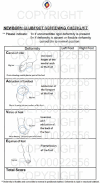Development and validation of the Newborn Clubfoot Screening Checklist to improve the detection of postnatal congenital talipes equinovarus among newborns by non-orthopaedic-trained healthcare workers in Sarawak General Hospital: A cross-sectional prospective study
- PMID: 39654868
- PMCID: PMC11627168
- DOI: 10.51866/oa.697
Development and validation of the Newborn Clubfoot Screening Checklist to improve the detection of postnatal congenital talipes equinovarus among newborns by non-orthopaedic-trained healthcare workers in Sarawak General Hospital: A cross-sectional prospective study
Abstract
Introduction: Non-orthopaedic-trained healthcare professionals face challenges in identifying postnatal clubfoot deformities due to the lack of suitable assessment tools, resulting in misdiagnosis. Therefore, this study aimed to develop and validate the Neonatal Clubfoot Screening Checklist (NCSC) to assist non-orthopaedic-trained healthcare professionals in postnatal clubfoot assessment.
Methods: The NCSC development involved five phases: conceptual understanding of deformity components, creation of pictorial representations, tool structure design, content and face validation, pilot study and field study. A cross-sectional prospective study was conducted in Sarawak General Hospital from January to June 2021. Non-orthopaedic-trained healthcare professionals were randomly assigned to two groups: one utilising the NCSC for newborn screening and another without it. Results were compared with assessments by the paediatric orthopaedic team. Kappa agreement tests and sensitivity and specificity analyses were performed to evaluate the tool's reliability and validity, respectively.
Results: The content and face validity were satisfactory. Six hundred twelve feet were screened using the NCSC, and 596 feet were checked without the tool. The kappa agreement tests showed strong concordance (kappa coefficient=0.725-1.000, P<0.001) between the non-orthopaedic-trained personnel and paediatric orthopaedic team for all NCSC items. The NCSC exhibited 100% sensitivity, specificity and positive and negative predictive values.
Conclusion: The NCSC is a reliable tool for postnatal clubfoot screening, offering high sensitivity and specificity. It facilitates accurate differentiation of true-positive congenital talipes equinovarus from other foot conditions, reducing misdiagnoses and unnecessary referrals. The NCSC is valuable in resource-constrained settings and for healthcare professionals lacking specialised orthopaedic training.
Keywords: Clubfoot; Clubfoot assessment; Congenital talipes equinovarus; Newborn; Screening.
© Academy of Family Physicians of Malaysia.
Conflict of interest statement
All authors declare no conflicts of interest.
Figures



Similar articles
-
Interventions for congenital talipes equinovarus (clubfoot).Cochrane Database Syst Rev. 2020 May 15;5(5):CD008602. doi: 10.1002/14651858.CD008602.pub4. Cochrane Database Syst Rev. 2020. PMID: 32412098 Free PMC article.
-
A survey on idiopathic congenital talipes equinovarus (ICTEV) managed by the Ponseti technique at Mulago Hospital - Uganda.Pan Afr Med J. 2021 Apr 23;38:397. doi: 10.11604/pamj.2021.38.397.26560. eCollection 2021. Pan Afr Med J. 2021. PMID: 34381541 Free PMC article.
-
Value of the fetal plantar shape in prenatal diagnosis of talipes equinovarus.J Ultrasound Med. 2012 Jul;31(7):997-1002. doi: 10.7863/jum.2012.31.7.997. J Ultrasound Med. 2012. PMID: 22733848
-
Interobserver reliability in Pirani clubfoot severity scoring between a paediatric orthopaedic surgeon and a physiotherapy assistant.J Pediatr Orthop B. 2012 Jul;21(4):366-8. doi: 10.1097/BPB.0b013e3283514183. J Pediatr Orthop B. 2012. PMID: 22343939
-
Evaluation of a simple tool to assess the results of Ponseti treatment for use by clubfoot therapists: a diagnostic accuracy study.J Foot Ankle Res. 2019 Mar 4;12:14. doi: 10.1186/s13047-019-0323-4. eCollection 2019. J Foot Ankle Res. 2019. PMID: 30867682 Free PMC article.
References
-
- Ponseti IV. Congenital Clubfoot: Fundamentals of Treatment. Oxford Medical Publications; Oxford University Press: 1996.
-
- Boo N-Y, Ong LC. Congenital talipes in Malaysian neonates: incidence, pattern and associated factors. Singapore Med J. 1990;31(6):539–542. - PubMed
LinkOut - more resources
Full Text Sources
